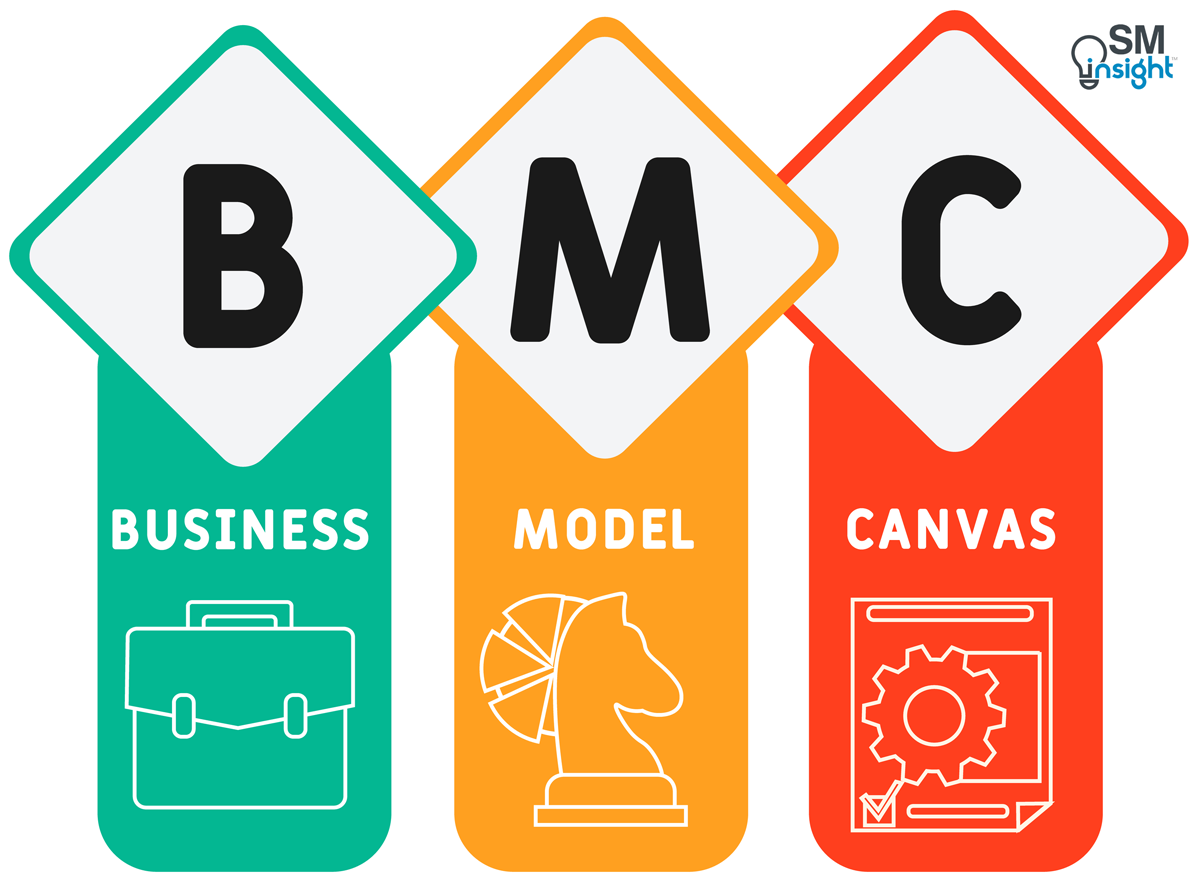What is the Business Model Canvas
Business Model Canvas (BMC) is a framework that helps determine how a business creates, delivers, and captures values. It is a visual representation of the important aspects or parts to consider when designing a Business Model.
BMC aids in constructing a shared understanding of a business by condensing it into a simple, relevant, and intuitively understandable one-page visual while not oversimplifying the complexities of how enterprises function.
This concept has been applied and tested around the world and is used in organizations such as GE, P&G, Nestlé, IBM, Ericsson, and Deloitte, including Government Services of Canada and many more[1],[2].
The Nine Building Blocks
BMC describes a business through nine basic building blocks that show the logic of how a business intends to make money. These nine blocks cover the four main areas of a business: Customers, Offer, Infrastructure, and Financial Viability.
BMC acts as a shared language for describing, visualizing, assessing, and changing business models. It is like a blueprint for a strategy to be implemented through organizational structures, processes, and systems.
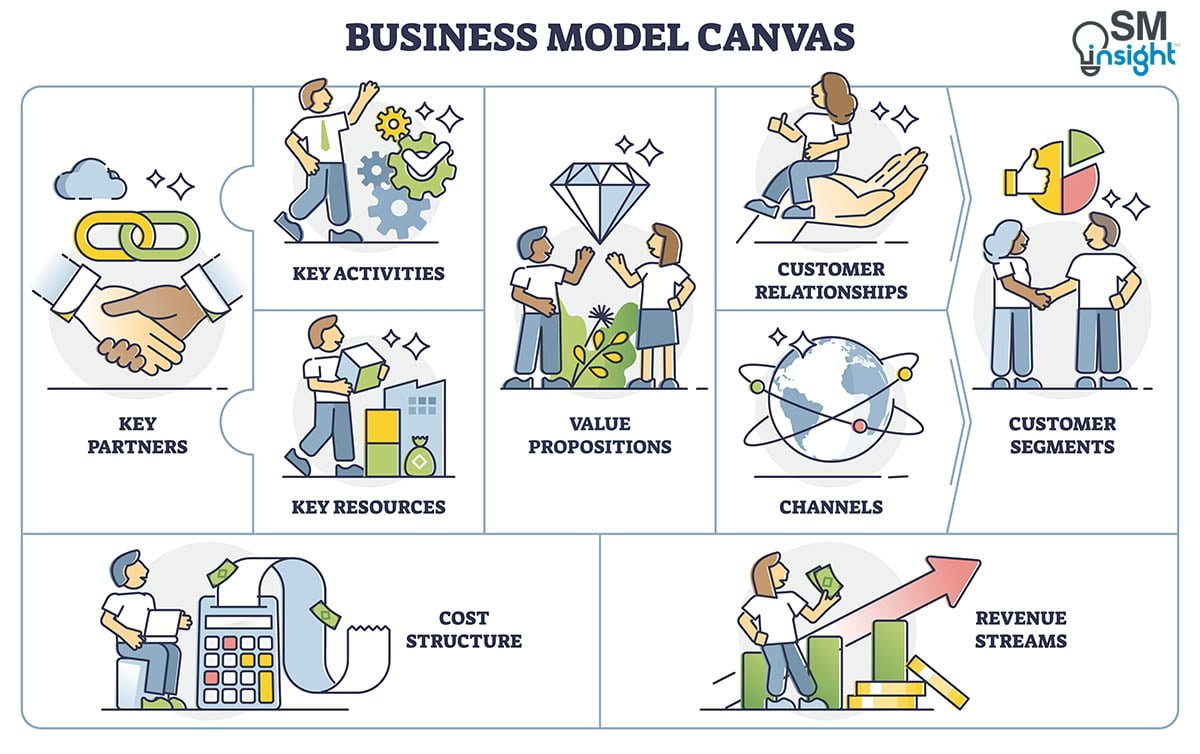
Each of these blocks is explained in more detail as follows:
1. Customer Segments (CS)
These are the groups of people or organizations that a business aims to reach and serve. Customers are the heart of a business model, and without (profitable) customers, a business cannot survive.
Customers are grouped into distinct segments with common needs, common behaviors, or other attributes. Customer groups represent separate segments if:
- Their needs require and justify a distinct offer.
- They are reached through different Distribution Channels.
- They require different types of relationships.
- They have substantially different profitability.
- They are willing to pay for different aspects of the offer.
An organization must make a conscious decision about which segment(s) to serve and which segments to ignore. Once this decision is made, a business model can be carefully designed around a strong understanding of specific customer needs.
The following two questions, if answered with clarity, help a business identify its CS.
- For whom are we creating value?
- Who are our most important customers?
- What are the customer archetypes?
Examples of some of the Customer Segments are shown in the figure:
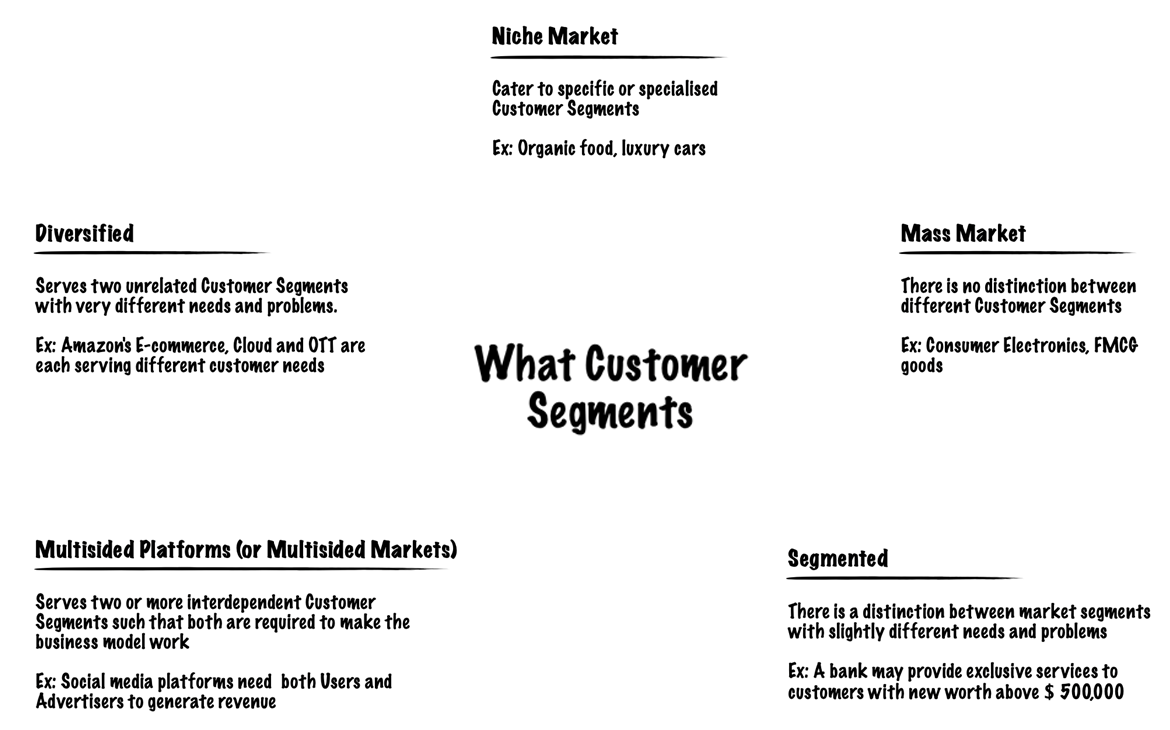
2. Value proposition (VP)
Value Proposition describes the bundle of products and services that create value for a specific Customer Segment chosen by a business.
A VP is the reason why customers turn to one company over another. VP must solve a customer’s problem or satisfy a need. A business can have more than one VP, but each must consist of a selected bundle of products and/or services that caters to the requirements of a specific Customer Segment.
While some VPs may be innovative and represent a new or disruptive offer, others may be similar to existing market offers but with added features and attributes.
An organization’s VP must answer the following questions with clarity:
- What value do we deliver to the customer?
- Which one of our customer’s problems are we helping to solve?
- Which customer needs are we satisfying?
- What bundles of products and services are we offering to each CS?
Elements from some of the following can contribute to customer value creation:
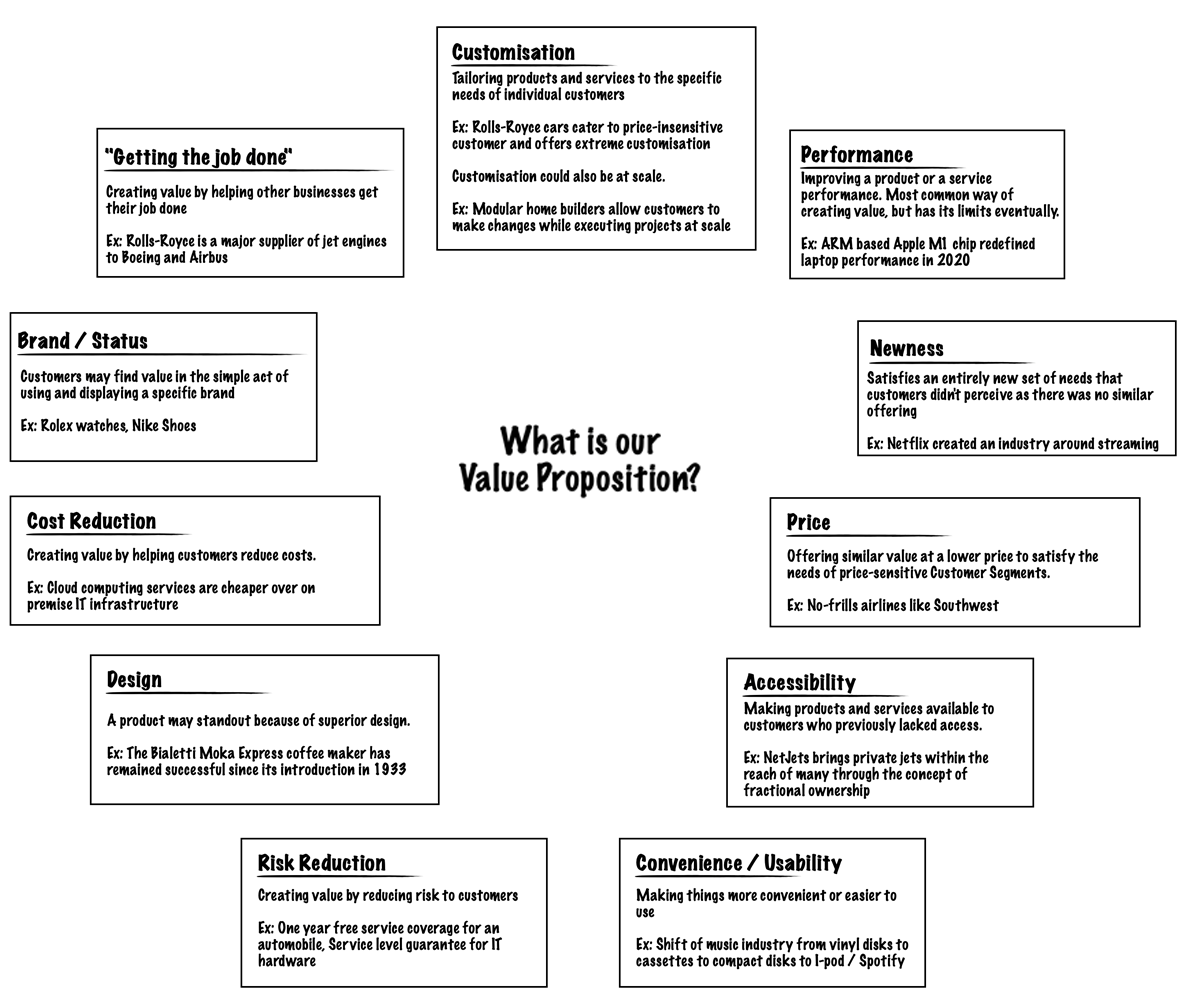
3. Channels (CH)
Channels describe how a company communicates with and reaches its Customer Segments to deliver a Value Proposition.
Channels are customer touch points that play an important role in the customer experience and serve several functions, including:
- Raising awareness about a company’s products and services
- Helping customers evaluate a company’s Value Proposition
- Allowing customers to purchase specific products and services
- Delivering a Value Proposition to customers
- Providing post-purchase customer support
To establish an effective channel, a company must first answer the following:
- Through which Channels do our Customer Segments want to be reached?
- How are we reaching them now?
- How are our Channels integrated?
- Which ones work best?
- Which ones are most cost-efficient?
- How are we integrating them with customer routines?
There are five distinct phases (figure below) through which a channel passes, and it could cover more than one of these phases at a time.

Channels can be either direct, indirect or hybrid, as shown:
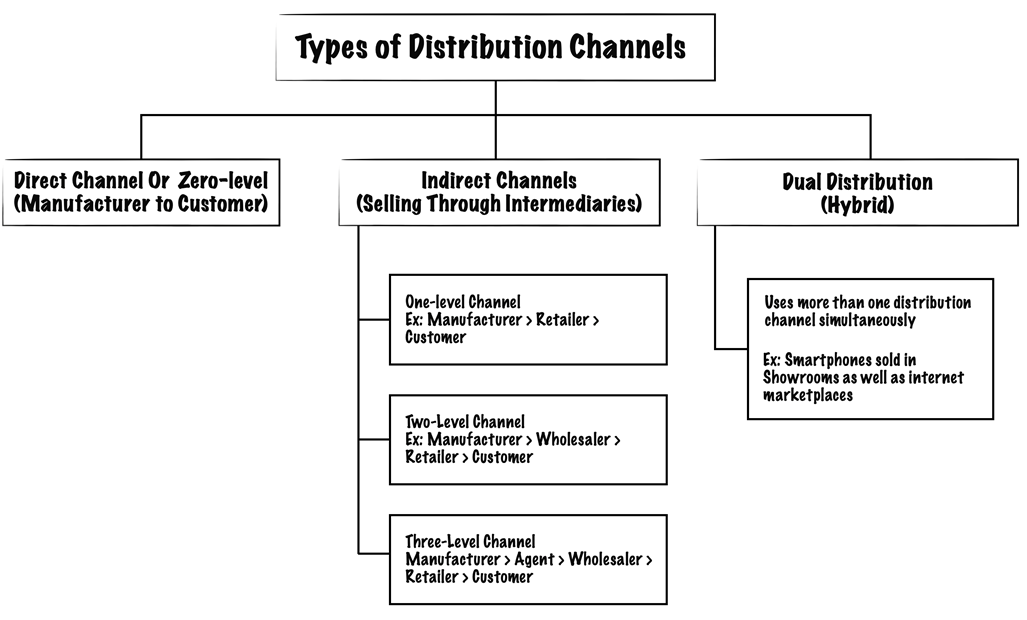
Finding the right mix of Channels to satisfy how customers want to be reached is crucial in bringing a Value Proposition to market and can create a great customer experience.
4. Customer Relationships (CR)
Customer Relationships describe the types of relationships a company establishes with specific Customer Segments. Relationships can range from personal to automated. An organization’s CR strategy may be driven by one of the following motivators:
- Customer acquisition
- Customer retention
- Boosting sales (upselling)
A business can arrive at the optimum CR by asking the following questions:
- What type of relationship does each of our Customer Segments expect us to establish and maintain with them?
- Which ones have we established?
- How costly are they?
- How are they integrated with the rest of our business model?
Several categories of Customer Relationships may co-exist in a company’s relationship with a particular Customer Segment. Some of which are:

5. Revenue Streams (RS)
Revenue Streams represent the company’s cash (earnings) from each Customer Segment and are like the arteries of any business.

There are two distinct categories of Revenue Streams:
- Transaction Revenues which are one-time customer payments
- Recurring Revenues that are ongoing payments to either deliver a Value Proposition to customers or provide post-purchase customer support
A business can arrive at its ideal revenue stream by asking the following questions:
- For what value are our customers willing to pay?
- For what do they currently pay?
- How are they currently paying?
- How would they prefer to pay?
- How much does each Revenue Stream contribute to overall revenues?
There are several ways a business can generate revenue, such as:
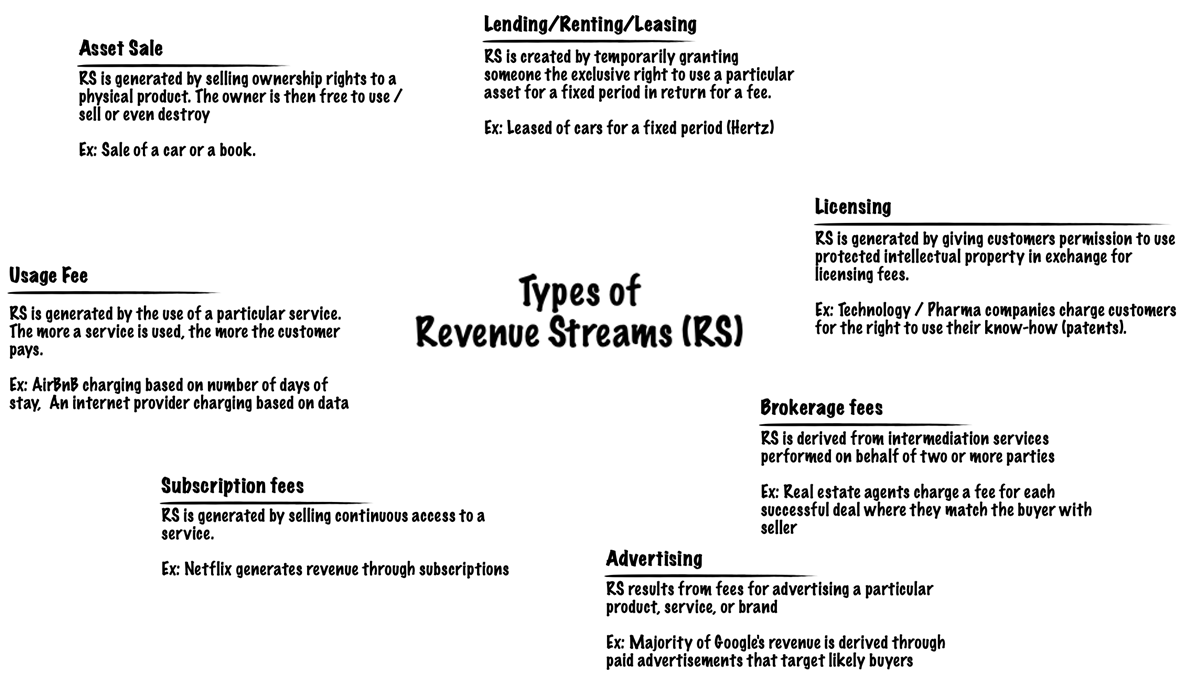
A business may have one or more Revenue Streams, each with different pricing mechanisms. The choice of pricing mechanism greatly influences the revenues generated.
There are two main types of pricing mechanisms, Fixed and Dynamic, as follows:
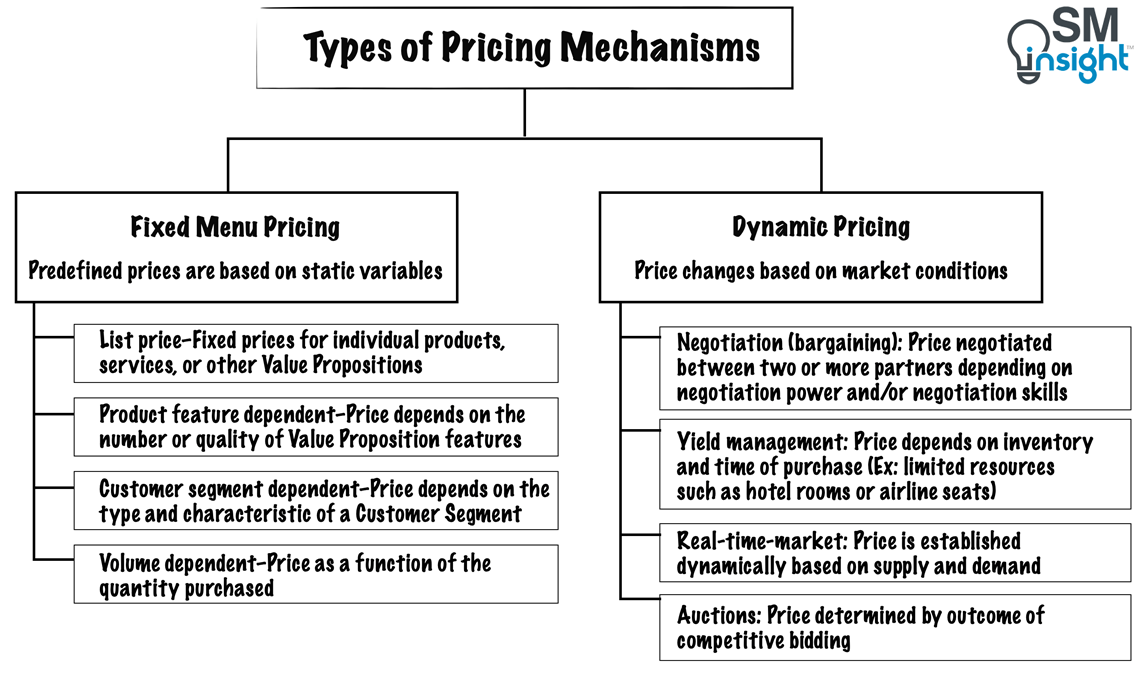
6. Key Resources (KR)
The Key Resources describe the most important assets required to make a business model work.
These resources allow an enterprise to create and offer a Value Proposition, reach markets, maintain relationships with Customer Segments, and earn revenues. Different Key Resources are needed depending on the type of business model.
For example, a chip fabrication business like TSMC[9] requires capital-intensive facilities worth billions of dollars, while a chip designer like NVIDIA[10] would need skilled manpower as its Key Resource.
Key Resources can be owned or leased by a business or acquired from its key partners. They can be identified by answering the following questions:
- What Key Resources do our Value Propositions require?
- What resources are required to sustain our Distribution Channels, Customer Relationships and Revenue Streams?
Key Resources can be categorized as follows:
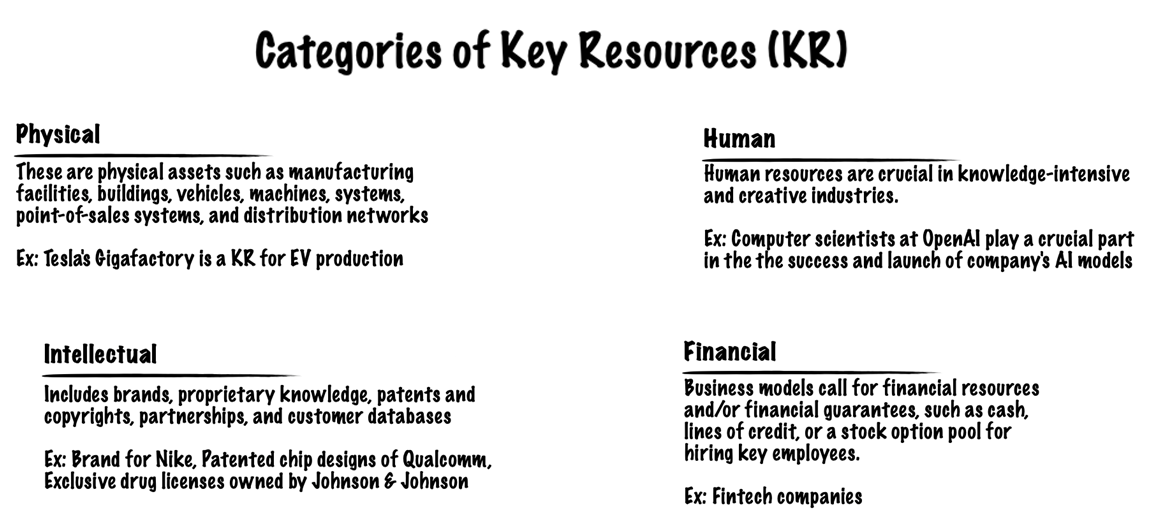
7. Key Activities (KA)
Key Activities describe the most important things a company must do to make its business model work. They are required to create and offer a Value Proposition, reach markets, maintain Customer Relationships, and earn revenues.
Key Activities differ depending on the business model type. For example, Microsoft’s Key Activity is software development, while for Dell, it is Supply Chain Management. For a consultancy firm like McKinsey, Key Activity is problem-solving.
A business can identify its Key Activities by answering the following questions:
- What Key Activities do our Value Propositions require?
- What activities directly contribute to maintaining our Distribution Channels, Customer Relationships and Revenue Streams?
Key Activities can be categorized as follows:
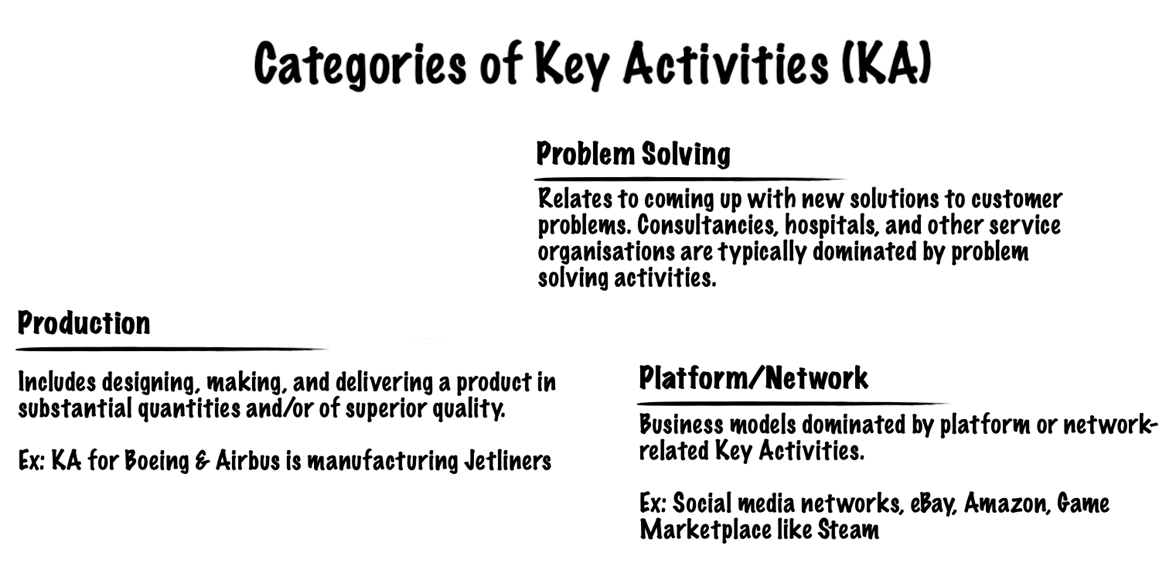
8. Key Partnerships (KP)
The Key Partnerships describe the network of suppliers and partners that make the business model. There are four types of partnerships:
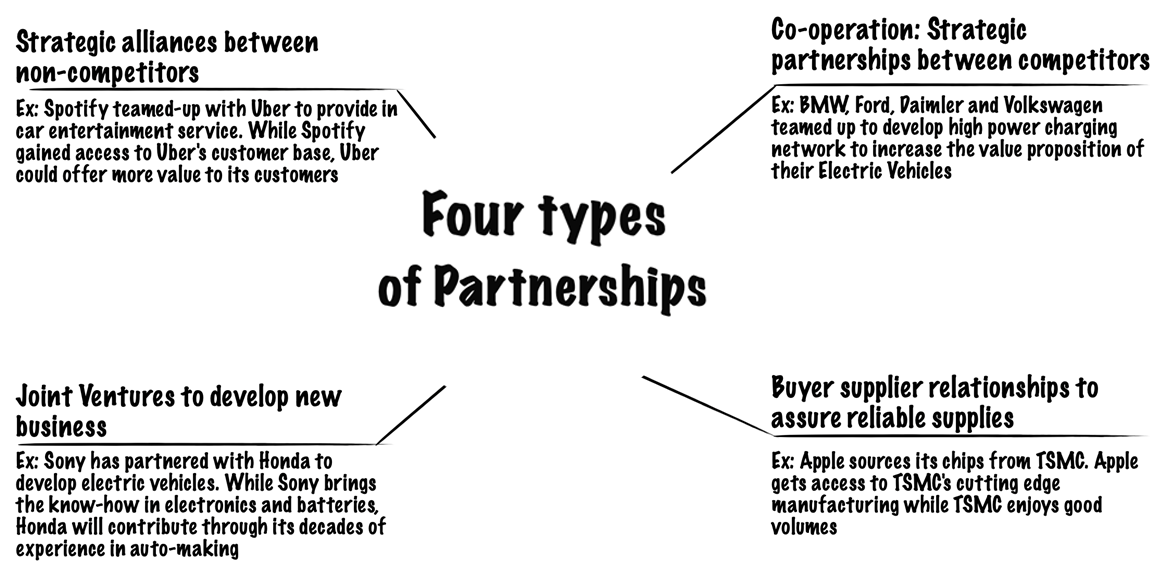
A business must ask the following questions before forming partnerships:
- Who are our key partners?
- Who are our key suppliers?
- Which Key Resources are we acquiring from partners?
- Which Key Activities do partners perform?
Primarily, there are three motivations for a business when creating partnerships, as shown:
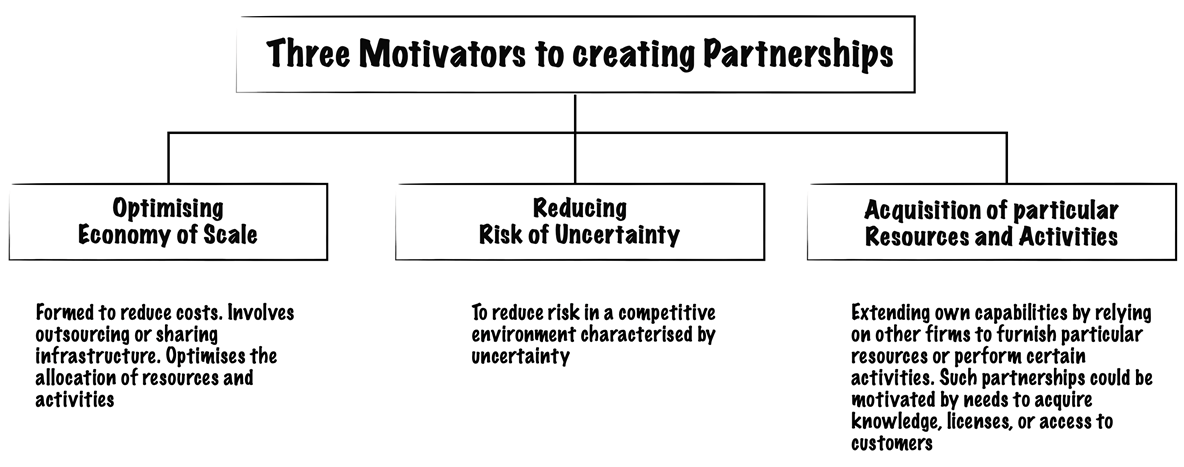
9. Cost Structure (CS)
Cost Structure describes all costs incurred to operate a business model. A business incurs costs in creating and delivering value, maintaining customer relationships, and generating revenue. Costs are business-specific, where some are more cost-driven than others.
A business must answer the following questions to arrive at an optimum cost structure:
- What are the most important costs inherent in our business model?
- Which Key Resources are most expensive?
- Which Key Activities are most expensive?
While costs should be minimized in every business model, it is useful to distinguish between two broad classes of business model Cost Structures:
- Cost Driven: This model focuses on minimizing costs wherever possible. This approach aims at creating and maintaining the leanest possible Cost Structure, using low-price Value Propositions, maximum automation, and extensive outsourcing. Examples: No frills airlines like Southwest & easyJet, Fast food joints such as McDonald’s & KFC.
- Value Driven: Premium Value Propositions and a high degree of personalized service usually characterize value-driven business models. Examples: Luxury hotels, Expensive Cars like Rolls-Royce
Cost Structures can have the following characteristics:
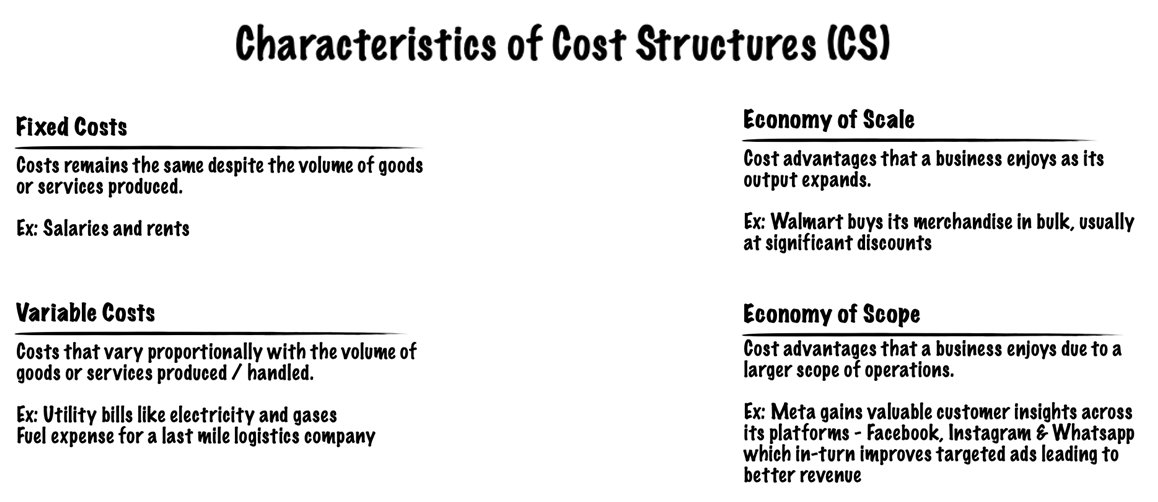
Putting-it-all together
The nine business model Building Blocks form the basis for a handy tool, which is called the Business Model Canvas (figure below). This tool resembles a painter’s canvas preformatted with nine blocks that allow painting pictures of new or existing business models. It is a hands-on tool that fosters understanding, discussion, creativity, and analysis.
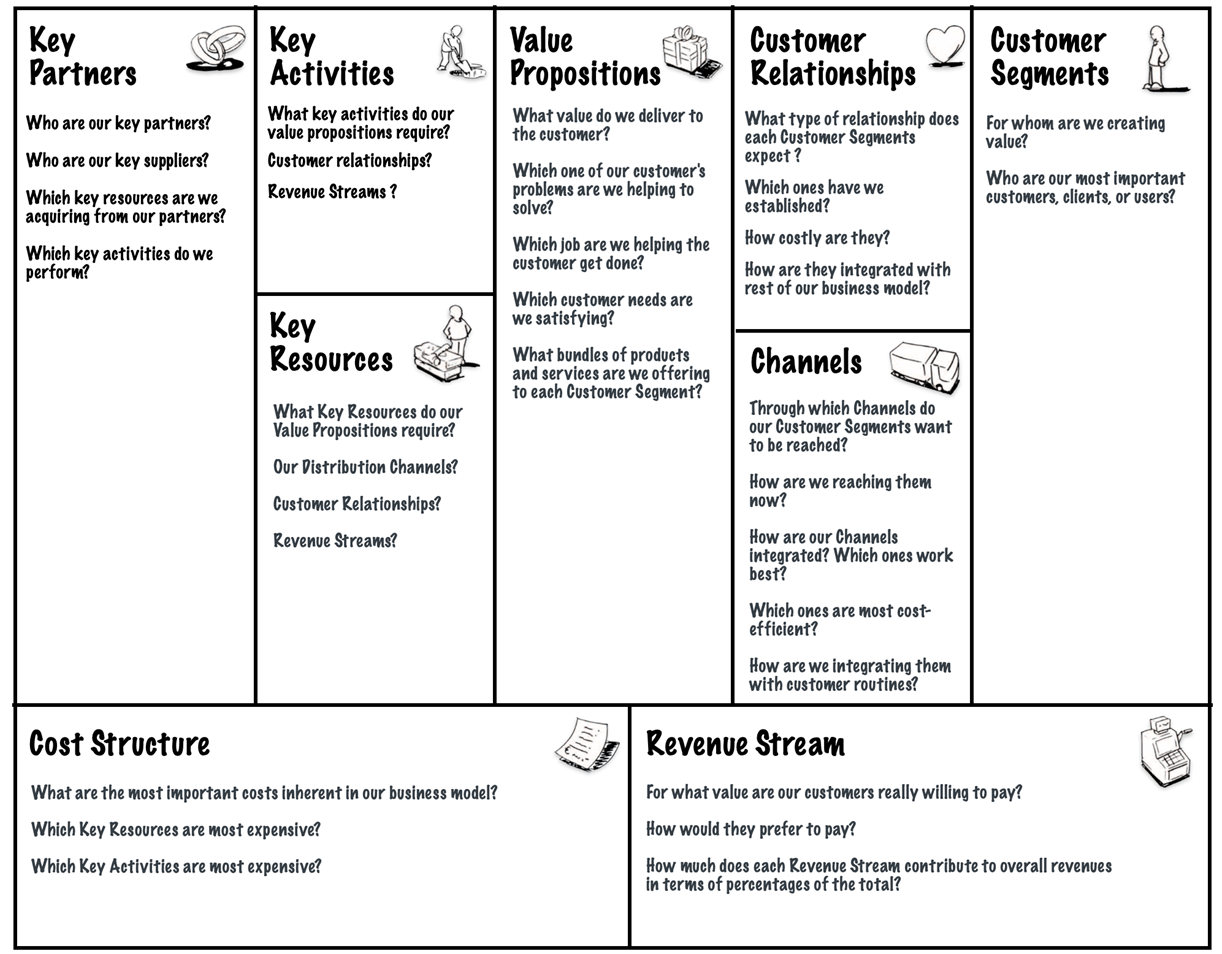
BMC works best when printed out on a large surface such that groups of people can jointly note, sketch, and discuss business model elements.
Example of Business Model Canvas
Nespresso[17], a fully owned daughter company of Nestlé, changed the dynamics of the coffee industry by turning a transactional business (selling coffee through retail) into one with recurring revenues (selling proprietary pods through direct channels).
The two-part strategy involved selling their patented coffee machine to retail customers first to lock them into the brand. This generated a recurring demand for coffee refills (pods) that led to constant revenues. These pods were sold directly through mail/website/own stores, thereby eliminating middlemen/dealers, which further increased profits[1].
Nespresso’s strategy plotted on a Business Model Canvas looks as follows:
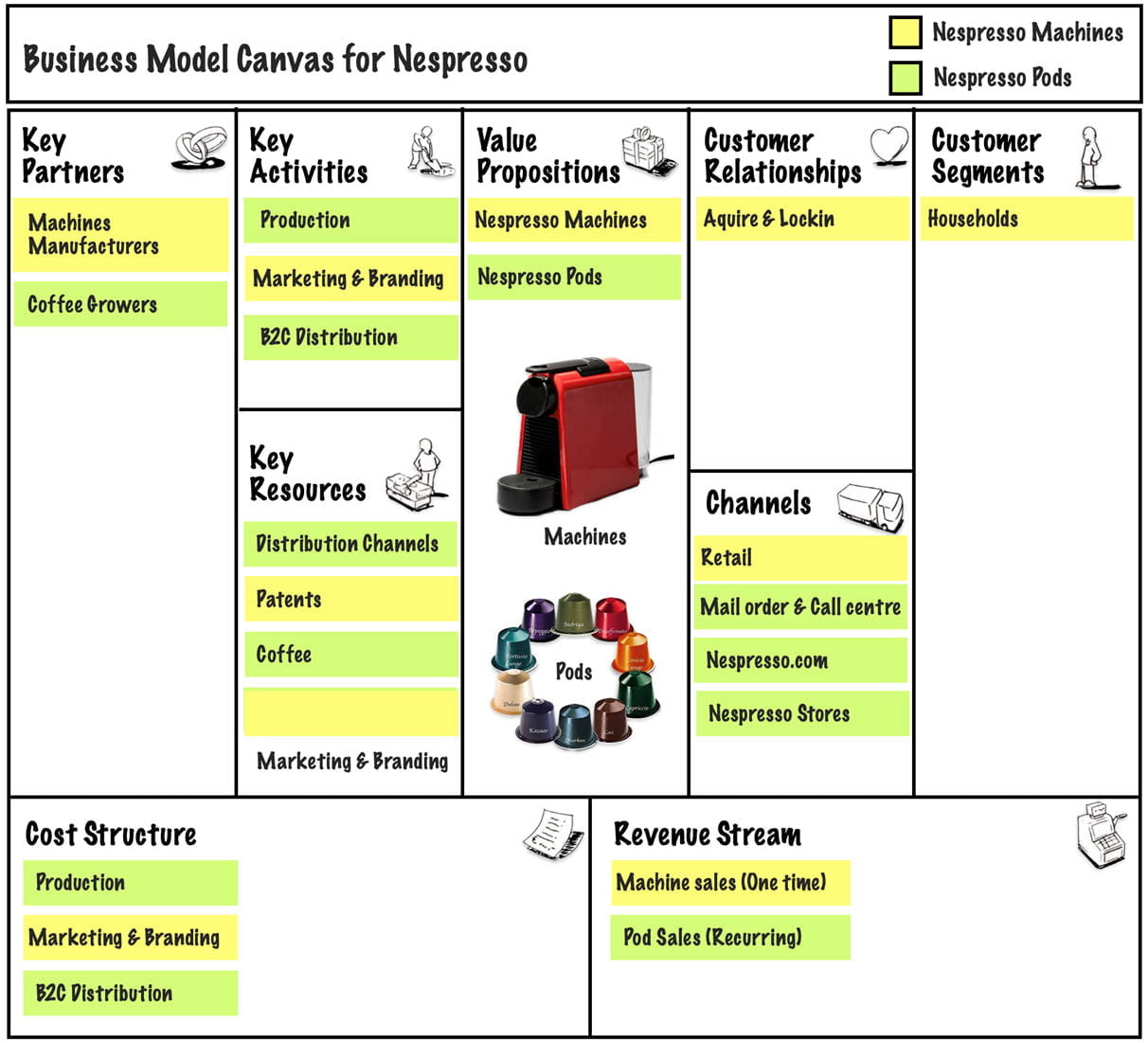
Business Model Canvas helped Nespresso establish a solid and enduring foundation by engaging consumers directly and bringing a barista-like experience within the reach of a home or an office.
Advantages & Limitations
Advantages
- Encourages Collaboration – collaborative framework, which helps put different business stakeholders in sync. This improves the likelihood of generating new ideas and their quality.
- Facilitates testing of ideas before launch – allows business owners, strategists, and managers to think through business ideas as well as test concepts that would otherwise get tested with potential customers where the stakes are higher.
- Customer-centered approach – Key customer segments, relationships, activities, and value propositions are all elements that focus on creating, delivering, and capturing value for customers.
- Clarity – Analyzing the business through the lens of nine blocks brings better clarity and structure to the business model.
Limitations
- Lacks a section for defining the start-up’s mission statement, which is crucial to understanding the goals and objectives of any business.
- Overlooks the importance of a profit mechanism beyond costs and revenues, including decisions on how to use potential profits.
- The order of the canvas is not intuitive, making it difficult to read and understand the strategic decisions in a logical sequence.
- Does not depict interconnections between different elements, which can have a significant impact on the overall business model.
- Fails to acknowledge the company’s role within its ecosystem, including its impact on the environment and local communities.
- External factors such as competition, history, and other industry-specific factors are absent from the canvas, which can greatly influence the success of a business model.
Sources
1. “A Better Way to Think About Your Business Model”. Harvard Business Review, https://hbr.org/2013/05/a-better-way-to-think-about-yo. Accessed 01 Aug 2023
2. “Business Model Generation”. Alexander Osterwalder, https://www.strategyzer.com/books/business-model-generation. Accessed 28 Jul 2023
3. “The Apple M1 is a revolution that is changing the computing world”. Citymagazine, https://citymagazine.si/en/apple-m1-is-a-revolution-that-changes-the-computer-world/. Accessed 29 Jul 2023
4. “Mass Customization”. Corporate Finance Institute, https://corporatefinanceinstitute.com/resources/management/mass-customization/. Accessed 29 Jul 2023
5. “Moka Pot”. Wikipedia, https://en.wikipedia.org/wiki/Moka_pot. Accessed 29 Jul 2023
6. “NetJets Homepage”. NetJets, https://www.netjets.com/en-us/. Accessed 01 Aug 2023
7. “Distribution Channels – Definition, Types, & Functions”. Feedough, https://www.feedough.com/distribution-channels-definition-types-functions/. Accessed 30 Jul 2023
8. “Lease from Hertz”. Hertz, https://www.hertz.com/rentacar/rental-car/car-lease. Accessed 30 Jul 2023
9. “TSMC”. Wikipedia, https://en.wikipedia.org/wiki/TSMC. Accessed 30 Jul 2023
10. “NVIDIA”. Wikipedia, https://en.wikipedia.org/wiki/Nvidia. Accessed 30 Jul 2023
11. “BMW, Daimler, Ford and Volkswagen team up on high-power charging network”. Techcrunch, https://techcrunch.com/2017/11/03/bmw-daimler-ford-and-volkswagen-team-up-on-high-power-charging-network/. Accessed 31 Jul 2023
12. “Honda And Sony Combine Talents To Build Electric Vehicles”. Forbes, https://www.forbes.com/sites/peterlyon/2022/06/26/honda-and-sony-announce-joint-venture-to-build-electric-vehicles/. Accessed 31 Jul 2023
13. “Uber and Spotify launch car music playlist partnership”. BBC, https://www.bbc.com/news/technology-30080974. Accessed 31 Jul 2023
14. “Walmart Has the Scale and Infrastructure to Generate Positive Gains”. Yahoo Finance, https://finance.yahoo.com/news/walmart-scale-infrastructure-generate-positive-201822628.html. Accessed 31 Jul 2023
15. “Demand-Side Economies of Scope in Big Tech Business Modelling and Strategy”. MDPI, https://www.mdpi.com/2079-8954/10/6/246. Accessed 31 Jul 2023
16. “The Business Model Canvas”. Strategyzer, https://www.strategyzer.com/canvas/business-model-canvas. Accessed 31 Jul 2023
17. “HomePage”. Nespresso, https://www.nespresso.com/us/en/. Accessed 01 Aug 2023
18. “Business Model Canvas of Nespresso”. Alex Osterwalder, https://www.youtube.com/watch?v=dhQh-tryXOg. Accessed 01 Aug 2023
19. “Nespresso Capsule”. Electromall, https://electromall.net/product/nespresso-capsule/. Accessed 01 Aug 2023
20. “The Best Nespresso Machine (But It’s Not for Everyone)”. Newyork Times, https://www.nytimes.com/wirecutter/reviews/best-nespresso-machine/. Accessed 01 Aug 2023
21. “Business Model Canvas”. Think Design, https://think.design/user-design-research/business-model-canvas/. Accessed 01 Aug 2023
22. “6 Problems with the Business Model Canvas”. The Pourquoi Pas, https://www.thepourquoipas.com/post/problems-with-the-business-model-canvas. Accessed 01 Aug 2023

